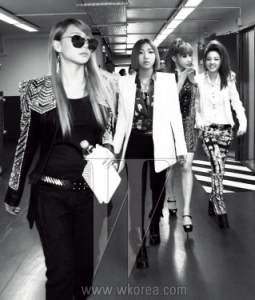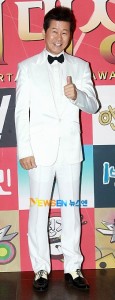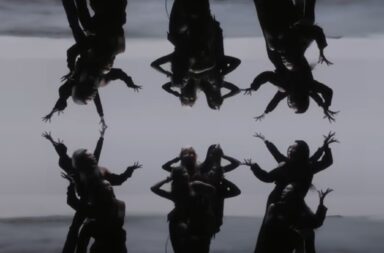 By now, there probably aren’t many diehard K-pop fans who haven’t heard 2NE1‘s latest single, “I Love You.” As with many 2NE1 releases, it blends distinct generes of music to create a completely unique style; in this case, it’s distinctive electronica coupled with the equally distinctive (and ever present) trot genre that defined Korean music of an older time. Upon first listen, it’s hard to miss the characteristic 1-2 beat that has marked trot genre for the past eighty years. However, most fans of contemporary K-pop probably wouldn’t be able to spot trot on their own, and even if they are aware that something is representative of trot music, the term might not really mean much. Even a lot of younger Koreans don’t really understand where the genre fits in among the glittery, glamorous spectacles so evocative of today’s Korean popular music. To them, it isn’t much more than the generically simple, played-out music that their parents and cab drivers listen to, music that middle-aged and old people sing to similarly middle-aged and old people.
By now, there probably aren’t many diehard K-pop fans who haven’t heard 2NE1‘s latest single, “I Love You.” As with many 2NE1 releases, it blends distinct generes of music to create a completely unique style; in this case, it’s distinctive electronica coupled with the equally distinctive (and ever present) trot genre that defined Korean music of an older time. Upon first listen, it’s hard to miss the characteristic 1-2 beat that has marked trot genre for the past eighty years. However, most fans of contemporary K-pop probably wouldn’t be able to spot trot on their own, and even if they are aware that something is representative of trot music, the term might not really mean much. Even a lot of younger Koreans don’t really understand where the genre fits in among the glittery, glamorous spectacles so evocative of today’s Korean popular music. To them, it isn’t much more than the generically simple, played-out music that their parents and cab drivers listen to, music that middle-aged and old people sing to similarly middle-aged and old people.
But what is trot? Surely it can’t be as simple as it is made out to be.
Trot music may very well be the first type of K-pop that ever existed — a possibility that may shock legions and legions of fans who assume that the K-pop that we know and love today is the representative genre of South Korea’s popular music scene. But labeling a style of music “pop music” can be something of a misnomer; pop culture itself has been and always will be constantly evolving with the times. The American pop music of 2012 certainly isn’t the same pop music that my parents grew up with decades ago, and so it is only fair to expect that what we today call K-pop was preceded by a different style of popular music for the masses. And it was.
[youtube http://www.youtube.com/watch?v=78tWqCi01Sw&w=560&h=315]Trot music traces its origins to the early 20th century, right around the time when the Korean peninsula was brought under Japanese control as a colony (annexation took place in 1910). Surprisingly (or maybe unsurprisingly), the genre didn’t exactly originate in Korea; rather, it was born in Japan from late 19th century protest songs and imported to Korea through a variety of channels. Japanese trot music, called enka, evolved largely in response to Meiji Japan’s call to modernize in the image of the era’s (supposedly more civilized) Euro-American powers; as such, it sought to incorporate more “modern” Western elements into traditional Japanese music in order to create modern pop music that was still palatable to a people unaccustomed to new sounds. Born from these efforts were the yonanuki major and minor scales ( Japanized adaptations of the pentatonic major and minor scales commonly employed in Western music — they are characterized by their lack of fourth and seventh degrees) as well as duple (1,2) rhythm borrowed from American foxtrot. As these musical elements made their way into Japanese music, so were they transmitted to the colonized people of Korea. At first Koreans took Japanese enka melodies and added their own lyrics, but gradually co-opted the genre and began producing their own recognizable trot. Its distribution was directly aided by Japanese policies that allowed Koreans a measure of control over their cultural content as well as the Japanese establishment of broadcasting companies and American record companies on Korean soil. The introduction of mass-produced music and radio led this primitive trot music to become the earliest form of Korean popular music — and some might even call it K-pop.
 Though the Japanese occupation ended in 1945, trot music continued to grow and evolve in the newly-formed South Korea; indeed, it was something of a creative outlet during a time of further oppression, as South Korea’s first three decades were characterized by authoritarian rule at the hands of two military dictatorships. It expanded in terms of both popularity and versatility, as trot singers continued to incorporate new styles of music popular in the United States and Europe into the standard trot format. However, while trot music of the past few decades can be fast, slow, bolero-inspired, jazzy, romantic, and a whole host of other styles, it has steadfastly retained its duple rhythm and use of the yonanuki scale. Its uniformity (and occasional monotony) has perhaps led to the genre’s classification as “unsophisticated,” but it probably also accounts for the genre’s endurance. In spite of many challenges (and the passage of many, many years) trot music still exists largely in its original form, and even South Korea’s largest pop acts have tested the waters of trot in their own music production. SNSD‘s Yuri and Sooyoung‘s song “For Sure” from the Working Mom OST is undoubtedly a foray into trot music, as is Seohyun and Ju Hyun-mi‘s collaboration “Jjalajajja.” Big Bang‘s Daesung‘s single “Look At Me, Gwi-soon” is also trot-inspired, as is girl group Gang Kiz‘s single “MAMA.” Trot is not hard to find even in South Korea’s modern music market.
Though the Japanese occupation ended in 1945, trot music continued to grow and evolve in the newly-formed South Korea; indeed, it was something of a creative outlet during a time of further oppression, as South Korea’s first three decades were characterized by authoritarian rule at the hands of two military dictatorships. It expanded in terms of both popularity and versatility, as trot singers continued to incorporate new styles of music popular in the United States and Europe into the standard trot format. However, while trot music of the past few decades can be fast, slow, bolero-inspired, jazzy, romantic, and a whole host of other styles, it has steadfastly retained its duple rhythm and use of the yonanuki scale. Its uniformity (and occasional monotony) has perhaps led to the genre’s classification as “unsophisticated,” but it probably also accounts for the genre’s endurance. In spite of many challenges (and the passage of many, many years) trot music still exists largely in its original form, and even South Korea’s largest pop acts have tested the waters of trot in their own music production. SNSD‘s Yuri and Sooyoung‘s song “For Sure” from the Working Mom OST is undoubtedly a foray into trot music, as is Seohyun and Ju Hyun-mi‘s collaboration “Jjalajajja.” Big Bang‘s Daesung‘s single “Look At Me, Gwi-soon” is also trot-inspired, as is girl group Gang Kiz‘s single “MAMA.” Trot is not hard to find even in South Korea’s modern music market.
However, as popular as trot music is, there are many Koreans who would steadfastly prefer to not think of it as Korea’s most indigenous form of pop music — precisely because trot was never really indigenous to Korea in the first place. A plethora of historical evidence exists to support the ideas that (1) trot music is, as mentioned, largely an adaptation from a Japanese style of music, and (2) that trot would not have been able to expand on the Korean peninsula to the extent that it did without the infrastructure put in place by the Japanese colonial system. As such, a fierce debate hit Korean newspapers in 1984 as to whether or not trot could be considered Korean — and if it could not, whether or not Koreans should be reproducing it in the first place. Though the debate was basically inconclusive, it had the effect of alerting many ordinary citizens to the somewhat dark history of trot. Even years and years after Japanese colonialism had ended, the historical memory of the time remained (and still is) strong, vivid, and very much emphasized in many aspects of Korean society. That trot music, so beloved for generations, could be nothing more than a mark of the hated colonizer, was disquieting.
 But trot has survived — and even more than that, it has thrived. Though the historical link between Japanese enka and Korean trot music is difficult to dispute, there can be no question that Koreans made trot their own, and this seems to have trumped its foreign roots. Trot music lyrically and musically has expressed and continues to express the heart of the Korean people throughout history, and it is perhaps for this reason above all others that Koreans have chosen trot music time and time again. It’s a fact at this point: trot music just refuses to die, and I think it’s safe to say that we can expect it to keep showing up in what we today know as K-pop for quite some time.
But trot has survived — and even more than that, it has thrived. Though the historical link between Japanese enka and Korean trot music is difficult to dispute, there can be no question that Koreans made trot their own, and this seems to have trumped its foreign roots. Trot music lyrically and musically has expressed and continues to express the heart of the Korean people throughout history, and it is perhaps for this reason above all others that Koreans have chosen trot music time and time again. It’s a fact at this point: trot music just refuses to die, and I think it’s safe to say that we can expect it to keep showing up in what we today know as K-pop for quite some time.
If you’re a trot noob and you’re looking for some non-contemporary trot music, I’d recommend starting off with some Tae Jin-ah (you’ll likely know him as Eru‘s father!), Song Dae-gwan, and Lee Mi-ja. Happy listening! And let us know what you think of trot below!
(Lee, Young Mee. “The Beginnings of Korean Pop: Popular Music During the Japanese Occupation Era (1910-1945).” Translated by Gloria Lee Park. In Korean Pop Music: Riding the Wave. Edited by Keith Howard, 1-9. Kent: Global Oriental Ltd., 1999, Robinson, Michael. “Broadcasting, Cultural Hegemony, and Colonial Modernity in Korea, 1924-1945.” In Colonial Modernity in Korea. Edited by Gi-wook Shin and Michael Robinson, 52-69. Cambridge: The President and Fellows of Harvard College, 1999, Yahoo Korea)


